#san francisco chinatown
Explore tagged Tumblr posts
Text



Andrew Koji - Warrior (Season 3, 2023)
#andrew koji#warrior#warrior tv#action choreography#martial arts cinema#action cinema#fight scene#san francisco chinatown
30 notes
·
View notes
Text
Észrevétel: a kínai negyed az olasztól eltérően teljesen hajléktalan-mentes, az emberi jogokat közismerten leszaró kínaiak valahogyan távol tartják Chinatowntól a zombiszerű emberi roncsokat. Nem akarom tudni, hogy hogyan! Bár a friscoi kínai negyed Los Angeleshez hasonlósn is a hanyatlás jeleit mutatja, de azért nagyobb és élettelibb. Frisconak eleve nagyobb a kínai közössége, a buszokon kínaiul ( meg spanyol,tagalog) ki vannak írva az infók, pl. nőket fogdosni tilos.

Itt még akcentussal beszélik a kínait, törik az angolt, sőt vannak a kínai közösség kiszolgálására szakosodott autentikus boltok és étkezdék (Budapesten a kőbányai piacon lehet venni a kínai spécialitásokat, mint pl fogyasztásra kész füstölt csirkeláb meg kacsaláb, meg vastagbél... azóta is a mélyhűtőben rohad). Bár a mellékutcákban már vannak kiadatlan boltok, sőt egy pakisztáni szuvenírárus is betelepedett. Sajnos, itt rengeteg a turista + turistalehúzó hely, az LA kínai negyedtől eltérően nincsen 5 póló 10 dollárért lehetőség. Vegán zöldséges kaja egy echte kínai kifőzdében, ahol a helyszínen henteskedtek a hentesek: 11 dollar. Ugyanitt Mao relikviák, Bank of China ATM, sőt egy piros kommer zászló is lengedezett (LA-ban a köztársasági). Jah, vettem 10 dollárért egy lepedőnyi amerikai zászlót, hogy kilógassam a belvárosi ablakomban a muszkavezető, Orbán és Putyinrajongó mélymagyar csőcselék megörvendeztetésére ;)
Nade hova tüntek a friscoi Chinatownból a hajléktalanok?!!!
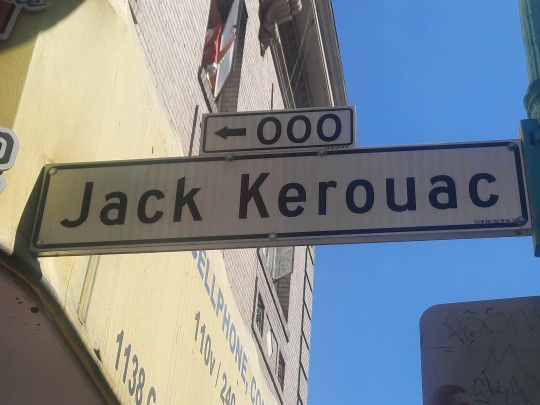
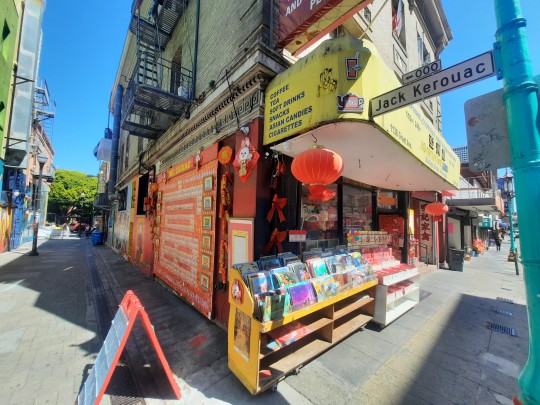

13 notes
·
View notes
Photo

A rainy Monday morning on Grant Avenue in Chinatown on Feb. 27, 2023. (Craig Lee/The Examiner)
10 notes
·
View notes
Photo

“Altar in the Chinese Joss-house, San Francisco. A probable illustration of Eastern Glory Temple from Harper’s Weekly, March 25, 1871.
The Eastern Glory Temple of Dupont Street
The “Eastern Glory” Temple (東華廟; canto: “Doong Wah miu;” pinyin: “Donghua miao”) reportedly opened in 1871 possibly at 929 Dupont Street. The Daily Alta California of February 10, 1871, reported that a temple “just completed by the six companies” was located in the third story of a row of buildings “on the west side of Dupont street on the west side of Dupont street, between Washington and Jackson.”
The reporter who had been invited to the inaugural rites at the new temple observed that the temple’s central hall honored “Pak Tie,” one of three gods whose statues were so honored. The temple also venerated in its center hall, Gwan Dai (關帝; pinyin: “Guāndì”), the God of War, and Hung Sing, the God of Water. Other deities were venerated in side rooms.




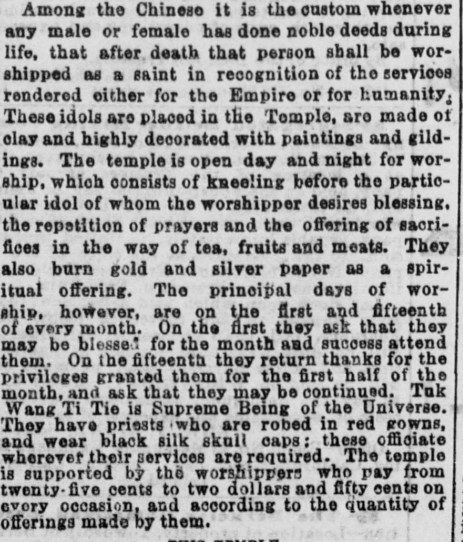



Less than a month later, the Daily Alta California on May 1, 1871, printed a critical letter to the editors from a reader, pointing out numerous inaccuracies in the previous news report. This letter contains the first reference to the temple as the “Tung Wah Min” in reference to its origins in southern China and, perhaps more significant, the poetic inscription which referred to the waves of blessing flowing to the men of eastern Cantonese men. The letter then described the temple’s veneration of “Pak Tie” (北帝; lit. "North Deity;" canto: “Buck Dai”), also known as the “God of the Eastern Peak.”

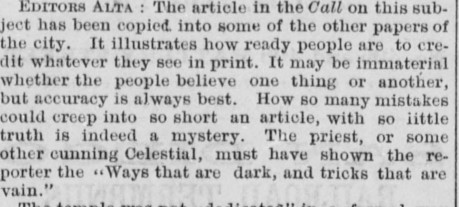






In his superb mapping project of the temples of old San Francisco Chinatown (found here), Peter Romaskiewicz asserts that pioneer photographer Eadweard Muybridge’s photograph “843 -- Chinese Joss House, Guardian of the Temple” c. 1871 was taken in the Eastern Glory Temple. The altar or central shrine shown in the photograph is consistent with the newspaper descriptions.

“843 – Chinese Joss House, Guardian of the Temple” c. 1871 - 1875. Photo by Eadweard Muybridge (from a private collection). The stereograph shows an altar in a temple that is probably the Tung Wah Miu (東華廟; canto: “Doong Wah miu;” pinyin: “Donghua miao”) or the “Eastern Glory” temple to non-Chinese.
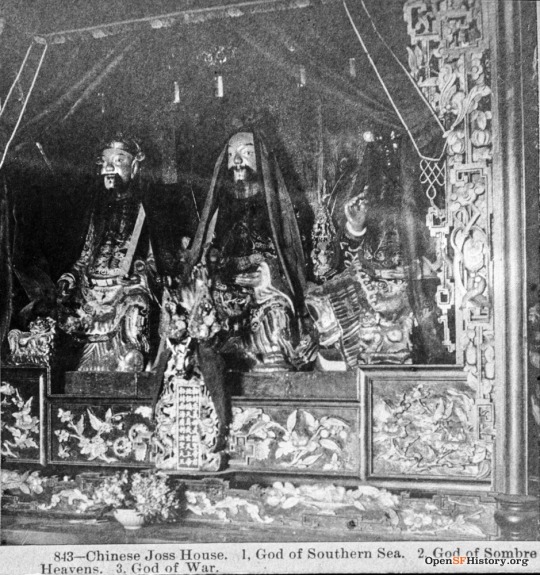
“843 – Chinese Joss House. 1, God of Southern Sea. 2, God of Sombre Heavens. 3. God of War” Detail of the altar of the Eastern Glory Temple, c.1871 - 1875, detail from a photo by Eadweard Muybridge (from the Marilyn Blaisdell collection). In Chinese, the God of Southern Sea would be 南海洪聖大王, Sombre Heaven is 玄武(or 真武)大帝, and the God of War is often ascribed to 關公 (canto: “Gwan Gung”).

The plaque seen in the Muybridge photo no. 843 presents deity names including “Pak Tie” (canto: “Buk Dai;” pinyin: “Beidi”).
As was the case of Chinatown’s other pre-1906 temples, the Eastern Glory temple was known for its elaborate ceremonies and festivals, which attracted Chinese immigrants from all over San Francisco and beyond. During these events, the temple would be filled with the sounds of traditional Chinese music and the smell of incense, as worshippers prayed and made offerings to the gods.
Assuming that Romaskiewicz accurately located Muybridge’s altar idols image no. 843, the numerical sequence of Muybridge’s other temple images indicates that Muybridge took at least two (and possibly three) photos before entering the Eastern Glory Temple and several other photographs at the same location after capturing image no. 843.
Two photos, 840 and 841, of “menshen” or door gods (文門神; canto: “munh moon sun”) have survived in various public and private collections. The door gods are usually presented in divine pairs, or Shenshu (Chinese: 神荼; Jyutping: “San4 Tou4″).

“840 – Chinese Joss House, Guardian of the Temple” c. 1871. Photo by Eadweard Muybridge (from the Marilyn Blaisdell collection and a stereoview titled “Guardian of the Door” in the collection of California State Library). Based on the negative no. 840, Muybridge probably took this photo of the other entry door to the Eastern Glory Temple before photographing the altar idols and door seen in his images no. 841 and 843. The guardian seen in this image is Shubao (叔寶; canto: “Sook Boh”) , one of two Tang dynasty generals whose image was ordered placed upon gates by the Great Ancestor of the Tang (“Emperor Taizong”).
Since the Tang dynasty, the deified generals Qin Shubao (Chinese: 秦叔寶; Jyutping: “Ceon4 Suk1 Bou2”) and Yuchi Gong (Chinese: 尉遲恭; Jyutping: “Wai3 Ci4 Gung1”) became most ubiquitous as martial door gods (武門神; canto: “moe munh sun;” lit. “military gate gods”). Moreover, the first Chinese in California identified often referred to themselves as “Tohng yahn” (lit. “Tang dynasty people”).

“841 – Chinese Joss House, Guardian of the Temple” c. 1871. Photo by Eadweard Muybridge published as a stereograph by Bradley & Rulofson (from the collection of the Getty Museum). Based on the “841” number, it can be inferred that Muybridge probably took this photo before entering the Eastern Glory Temple and photographing the altar idols seen in his image no. 843. The guardian seen in this image is Yuchi Gong(尉遲恭; canto: “Gwai Chee Gung”), one of two Tang dynasty generals whose image was ordered placed upon gates by the Great Ancestor of the Tang (“Emperor Taizong”).
Based on a comparison of the numerical labeling of the images, and a comparison of the partial signage seen in Muybridge’s photo no. 843, it is possible to connect several images taken of the temple’s resident priest(s) and astrologer outside the entrance.

“844 – Chinese Joss House. Tanist [sic] Priest in full costome.” Photographer Eadweard Muybridge (from the collection of the California State Library).

“Chinese Joss House, Tauist [sic] Priest In Full Costume” c. 1875 (from the collections of the Bancroft Library).

“845 - Chinese Joss House, Astrological Priest”(from the collection of the New York Public Library). This photo appears to have been taken in front of the same building as the photo no. 842 of the Taoist priest.

“846 – Chinese Joss House, Priests discussing Theology.”

“847 – Chinese Joss House. God of the Earth.”
Muybridge’s dogged persistence, and the apparent cooperation of the temple staff, produced an extant photographic record of the Eastern Glory temple provides perhaps the best documentation of the pre-1906 temples in San Francisco Chinatown.
Despite the challenges faced by the Chinese community in San Francisco, including discrimination, poverty, and violence, the Eastern Glory Temple remained a source of strength and resilience. It provided a sense of belonging and identity for the community, and helped to preserve traditional Chinese culture and beliefs in a foreign land.
However, the temple’s days came to an abrupt end in 1906, when a massive earthquake struck San Francisco and destroyed much of Chinatown. The Eastern Glory Temple was among the many buildings that were destroyed in the disaster. Despite its relatively short existence, the Eastern Glory Temple remains an important symbol of the resilience and perseverance of the Chinese community in San Francisco. Today, its legacy lives on through the many temples and cultural institutions that continue to thrive in Chinatown and beyond.
[updated: 2024-5-5]
#Eastern Glory Temple#929 Dupont St.#San Francisco Chinatown#Chinese joss house#Eadweard Muybridge#Beidi#Guandi#Daily Alta California#door gods#Qin Shubao#Yuchi Gong
2 notes
·
View notes
Text

Chinatown San Francisco August 2024
0 notes
Text

Irene Poon. Virginia. Chinatown, San Francisco 1965
347 notes
·
View notes
Text

Photographer Fred Herzog
#photography#fred herzog#san francisco#chinatown#analogue#film is not dead#coca cola#signs#street photography#new topographics
189 notes
·
View notes
Text
Bad Film - grain

February 2024
Location: Chinatown, San Francisco, California
#bad film series#photography#photoblog#photo blog#photographers of tumblr#photographers on tumblr#film photography#35mm#film#film camera#35mm camera#35mm color film#35mm photography#35mm film#grain#film grain#chinatown#san francisco#california
89 notes
·
View notes
Text


Orson Welles loitering in San Francisco's Chinatown
210 notes
·
View notes
Text

Chinatown SF | Cinestill 800
#photography#35mm film#35mm photography#film photography#minolta#shotonfilm#film is alive#cinestill800#cinestill#chinatown#san francisco#california#urban photography#golden hour#urban landscape
50 notes
·
View notes
Text


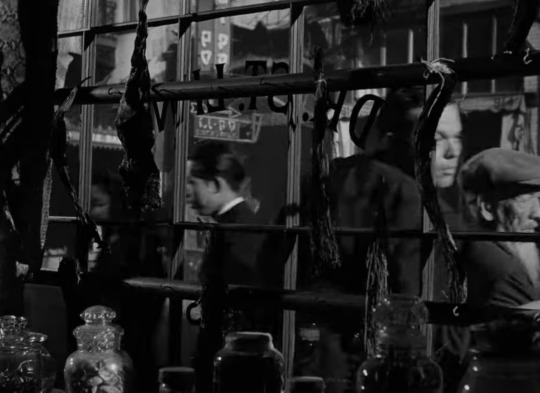
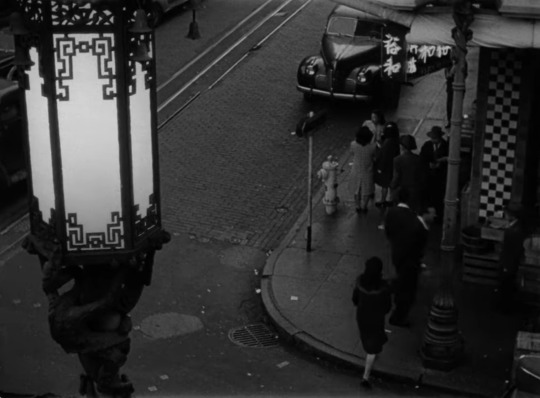


"The Lady from Shanghai (1947) directed by Orson Welles [...] was actually filmed in San Francisco's Chinatown but is edited in such a way that the space feels very confusing. There are Dutch angles, there are shots that take place through windows. It's difficult to tell where you stand in relationship to what. Why is this trope of being lost, or spatially disoriented, associated with East Asia?" Homay King, Staging the Orient
#san francisco#chinatown#the lady from shanghai#orson welles#m#switchboard girls and women gossiping in court i love u btw
91 notes
·
View notes
Text

Chinatown of San Francisco by night, CA, US
American vintage postcard
#postal#american#historic#ansichtskarte#chinatown#us american#sepia#vintage#tarjeta#briefkaart#photo#francisco#night#postkaart#san francisco#ephemera#postcard#postkarte#photography#carte postale
28 notes
·
View notes
Text

my friends won’t stop making fun of my wide legged pants like Yosemite Sam lookin ahhhhh
#me#selfie#self#ootd#blazer#midsize#girl#glasses#blonde#shag#sf#san francisco#Chinatown#california#clothes#sambas#paisley
48 notes
·
View notes
Photo

Where the New Met the Old: Chinatown’s First Car Show
Modern-day residents and visitors to San Francisco Chinatown might assume that automobile shows such as the Chinatown Car Weekend Car Show in 2022 represented a relatively recent phenomenon. As this advertisement for a Locomobile shows, such an assumption would be erroneous.
Sometime during 1901, the Locomobile Company of America, an early American automobile manufacturer founded in 1899, came to Chinatown to photograph its steam car where the new could be juxtaposed with the ancient. For reasons that remain lost to memory, the company or its ad agency chose to display its Locomobile Steam vehicle in front of the Tin How Temple on Waverly Place. The ad recites an August 12, 1901 event, when two Denver men named Yont and Felker drove to the top of Pike’s Peak. Their trip in a two-cylinder Locomobile Steamer took just over nine hours and was accomplished by pushing as well as driving to claim the distinction of being the first motorcar to reach the summit.
Until now, the precise location for the ad-shoot had also been lost to memory. Fortunately, enough of the temple's façade (including a portion of its vertical signage above and behind the driver's head), appeared behind the group of Chinatown onlookers. After comparing the ad with other photos of the pre-1906 temple, we now can identify where one of Chinatown's first car exhibitions occurred.

An enlargement of an ad which appeared on page 17 of a 1901 issue of the San Francisco Daily Times. This ad printed an alternate image of the photo session on Waverly Place in front of the Tin How Temple.

The Locomobile ad as it appeared on page 17 of the San Francisco Daily Times of 1901.
To view more pre-1906 photos of the Tin How Temple, go to my blog here or use this link: https://demospectator.tumblr.com/post/650038487091970048/tin-how-temple-of-old-san-francisco-chinatown
2 notes
·
View notes
Text


Treasure Island was first published as a book on 14 November 1883, by Cassell & Co.
#Robert Louis Stevenson Memorial by Bruce Porter#Treasure Island#USA#first published#14 November 1883#anniversary#San Francisco#summer 2017#Chinatown#California#public art#travel#vacation#original photography#book#author#tourist attraction#landmark#cityscape#writer
16 notes
·
View notes
Text

Cable Car climbing past Chinatown on California Street ★彡𝓛𝓓ミ★
22 notes
·
View notes